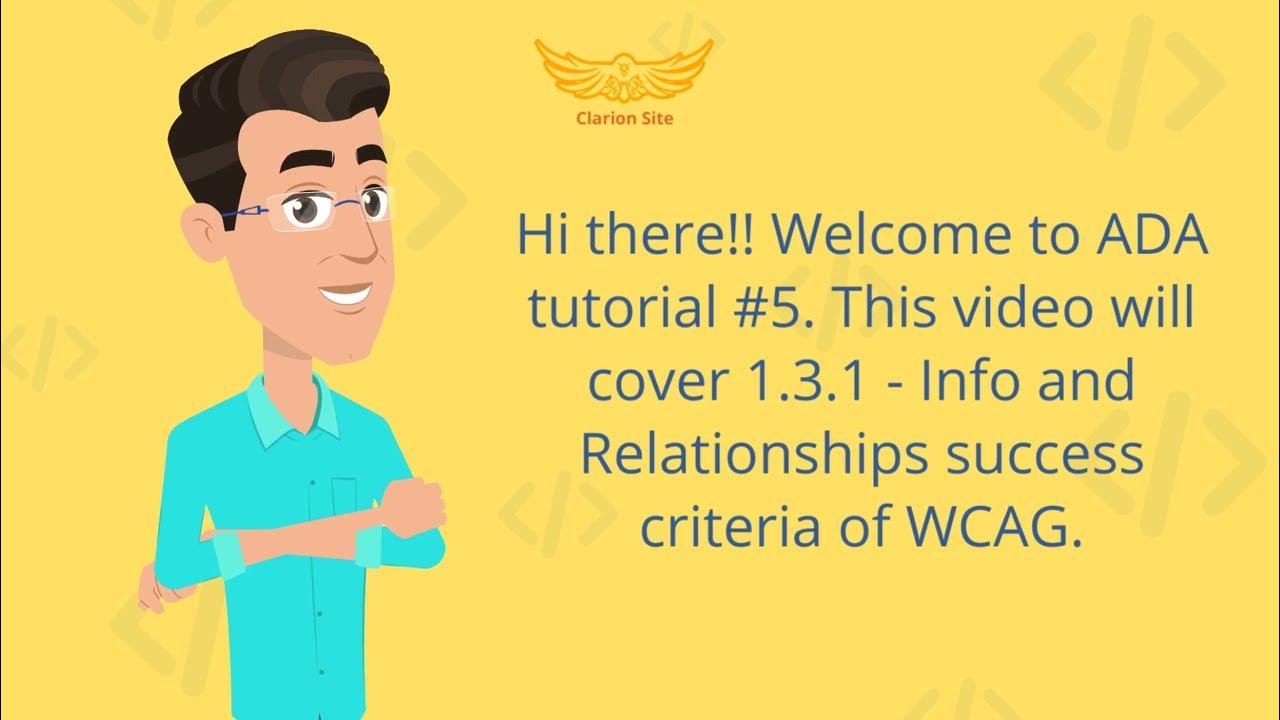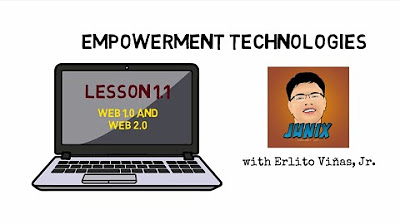WCAG - Web Content Accessibility Guidelines 2.1 Explained | Intellipaat
Summary
TLDRThis video script delves into the Web Content Accessibility Guidelines 2.1 (WCAG 2.1), emphasizing the importance of accessible web design for users with disabilities. It covers the evolution from WCAG 2.0, the four key principles of accessibility, and the criteria for compliance. The script also discusses testing methods, legal and ethical considerations, and best practices for developers. It concludes with future developments in web accessibility, advocating for an inclusive digital world.
Takeaways
- 🌐 **Web Accessibility Importance**: The script emphasizes the importance of web accessibility, highlighting that it ensures equal access to online information and services for everyone, including those with disabilities.
- 📝 **WCAG 2.1 Overview**: WCAG 2.1 stands for Web Content Accessibility Guidelines 2.1, a set of recommendations by the World Wide Web Consortium to make web content more accessible to individuals with disabilities.
- 🔄 **WCAG 2.1 Enhancements**: The script outlines that WCAG 2.1 includes additional success criteria over WCAG 2.0, addressing new technologies and providing more comprehensive accessibility guidelines for mobile devices, low vision users, and those with cognitive disabilities.
- 🏢 **Legal and Ethical Significance**: Adhering to WCAG 2.1 is not only a legal requirement in many countries but also an ethical imperative, reflecting social responsibility and human rights for people with disabilities.
- 🔑 **Key Principles of WCAG 2.1**: The script explains the four key principles of WCAG 2.1: Perceivable, Operable, Understandable, and Robust, which serve as the foundation for web accessibility.
- 📊 **Success Criteria Levels**: Success criteria in WCAG 2.1 are categorized into three levels of conformance—A, AA, and AAA—with AAA being the most stringent, aiming to provide a higher standard of accessibility.
- 🛠️ **Accessibility Testing**: The script discusses the necessity of accessibility testing, which can be manual, automated, or a combination of both, to identify and fix barriers that people with disabilities may face when using web content.
- 🛠️ **Testing Types**: Different types of testing are mentioned, including functionality, usability, and compliance testing, each serving a specific purpose in evaluating the accessibility of web content.
- 🔍 **Accessibility Tools and Resources**: A variety of tools and resources are available to assist developers and designers in testing for WCAG 2.1 compliance, ranging from automated testing tools to web developer tools and accessibility testing services.
- 📈 **Future Developments**: The script predicts future developments in web accessibility, including the use of AI and ML for personalized experiences, challenges with VR and AR technologies, a focus on mobile accessibility, and improved support for cognitive disabilities.
- 🤝 **Inclusive Digital World**: The conclusion calls for a collective effort from web developers, designers, and users to create a more accessible and inclusive digital world, reflecting a commitment to ongoing improvement in web accessibility.
Q & A
What is the main focus of the video on web accessibility guidelines 2.1?
-The video focuses on explaining the Web Content Accessibility Guidelines (WCAG) 2.1, discussing their importance, the differences from WCAG 2.0, key principles, success criteria, accessibility testing, tools and resources, legal and ethical considerations, best practices, and future developments in web accessibility.
Why is web accessibility important in today's digital age?
-Web accessibility is crucial because it ensures that everyone, including people with disabilities, has equal access to information and services online. As technology and the internet become more integral to our lives, accessibility becomes a legal requirement and a matter of social responsibility and human rights.
What are the four key principles of WCAG 2.1?
-The four key principles of WCAG 2.1 are Perceivable, Operable, Understandable, and Robust, which ensure that web content is accessible to all users, including those with disabilities.
How does WCAG 2.1 differ from WCAG 2.0?
-WCAG 2.1 includes additional success criteria that address new emerging technologies and accessibility issues not covered in WCAG 2.0, such as mobile accessibility, touchscreen functionality, and low vision accessibility.
What are success criteria in the context of WCAG 2.1?
-Success criteria are the specific guidelines in WCAG 2.1 that must be met to ensure web content is accessible to everyone. They are organized into three levels of conformance (A, AA, and AAA) and are grouped under 13 guidelines that correspond to the four key principles.
What is the purpose of accessibility testing?
-Accessibility testing is conducted to evaluate a website or web application to ensure it meets accessibility standards and is usable by people with disabilities. It aims to identify and fix barriers that may prevent access or use by these individuals.
What are some common accessibility testing methods?
-Accessibility testing can be done manually using assistive technologies or automated tools that scan for issues. It also includes functionality testing, usability testing, and compliance testing against specific standards like WCAG 2.1.
What are some examples of accessibility tools and resources mentioned in the video?
-Examples include automated testing tools like AXE, manual testing methods using assistive technologies, accessibility checkers such as WebAIM WAVE, web developer tools built into browsers, and third-party accessibility testing services.
What are some legal considerations regarding web accessibility?
-Legal considerations include compliance with laws like the American with Disabilities Act (ADA) in the United States and the European Union's web accessibility directive, which require equal access to web content for people with disabilities and can result in legal action for non-compliance.
What are some ethical considerations for web accessibility?
-Ethically, web accessibility is about social responsibility and human rights, ensuring that people with disabilities are not excluded from accessing information and participating in society. It also involves making web development tools and technologies accessible to people with disabilities.
What are some best practices for web accessibility mentioned in the video?
-Best practices include providing alternative text for images, using descriptive and concise link text, ensuring proper document structure with headings, ensuring sufficient color contrast, making forms accessible, providing accessible multimedia with transcripts and captions, ensuring keyboard accessibility, and conducting accessibility testing.
What future developments in web accessibility are highlighted in the video?
-The video mentions the potential of artificial intelligence and machine learning to improve accessibility, challenges and opportunities with virtual and augmented reality, the growing importance of mobile accessibility, improved accessibility for people with cognitive disabilities, and a greater emphasis on user testing involving people with disabilities.
Outlines

このセクションは有料ユーザー限定です。 アクセスするには、アップグレードをお願いします。
今すぐアップグレードMindmap

このセクションは有料ユーザー限定です。 アクセスするには、アップグレードをお願いします。
今すぐアップグレードKeywords

このセクションは有料ユーザー限定です。 アクセスするには、アップグレードをお願いします。
今すぐアップグレードHighlights

このセクションは有料ユーザー限定です。 アクセスするには、アップグレードをお願いします。
今すぐアップグレードTranscripts

このセクションは有料ユーザー限定です。 アクセスするには、アップグレードをお願いします。
今すぐアップグレード関連動画をさらに表示

WCAG - 1.3.1 Info and Relationship - ADA Tutorial # 5

ID: Apps Pod 02

MOOC Introducción al Desarrollo Web, parte 2 - 4.10 ¿Usabilidad,... (parte 3) - Google Actívate

Web 3.0 Advantages and Disadvantages.

Semantic Tags Explained | Frontend Bootcamp Hindi | Ep.04

Empowerment Technologies | Lesson 1.1: Web 1.0 and Web 2.0
5.0 / 5 (0 votes)
